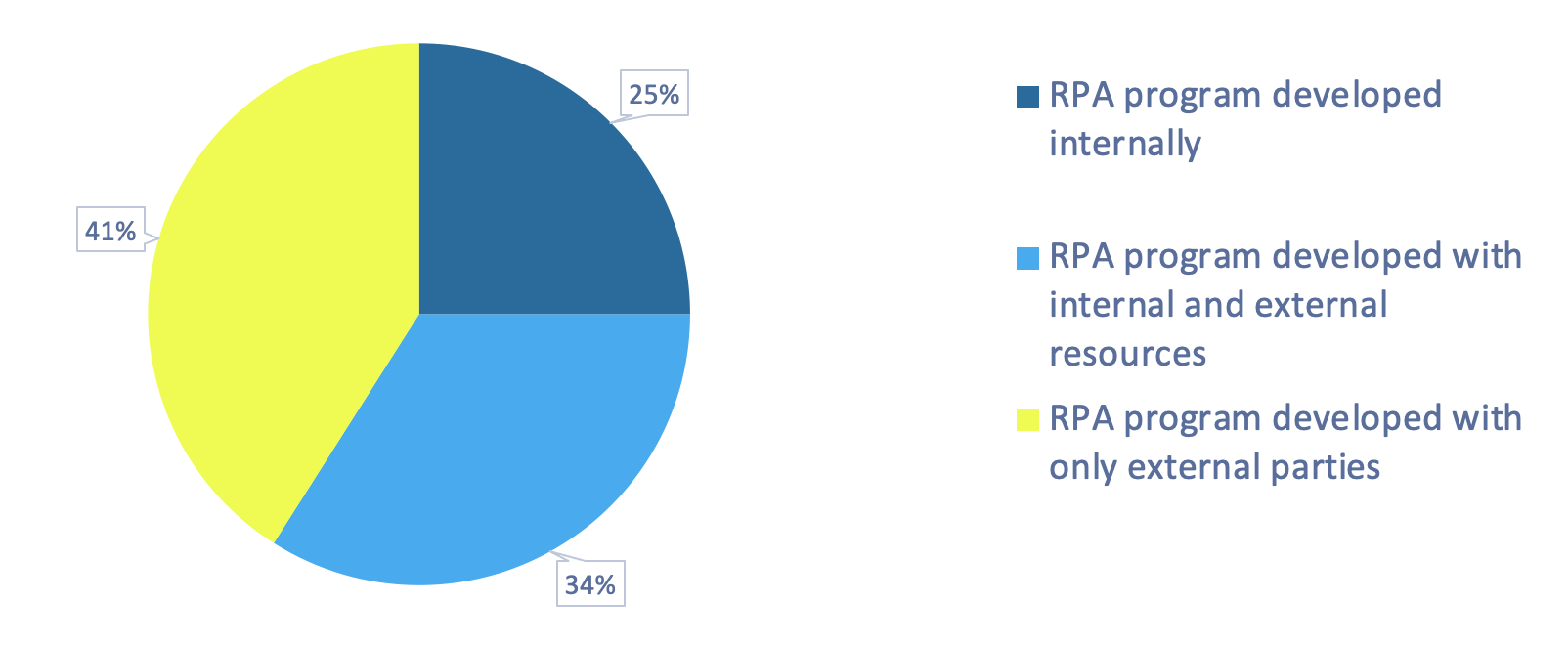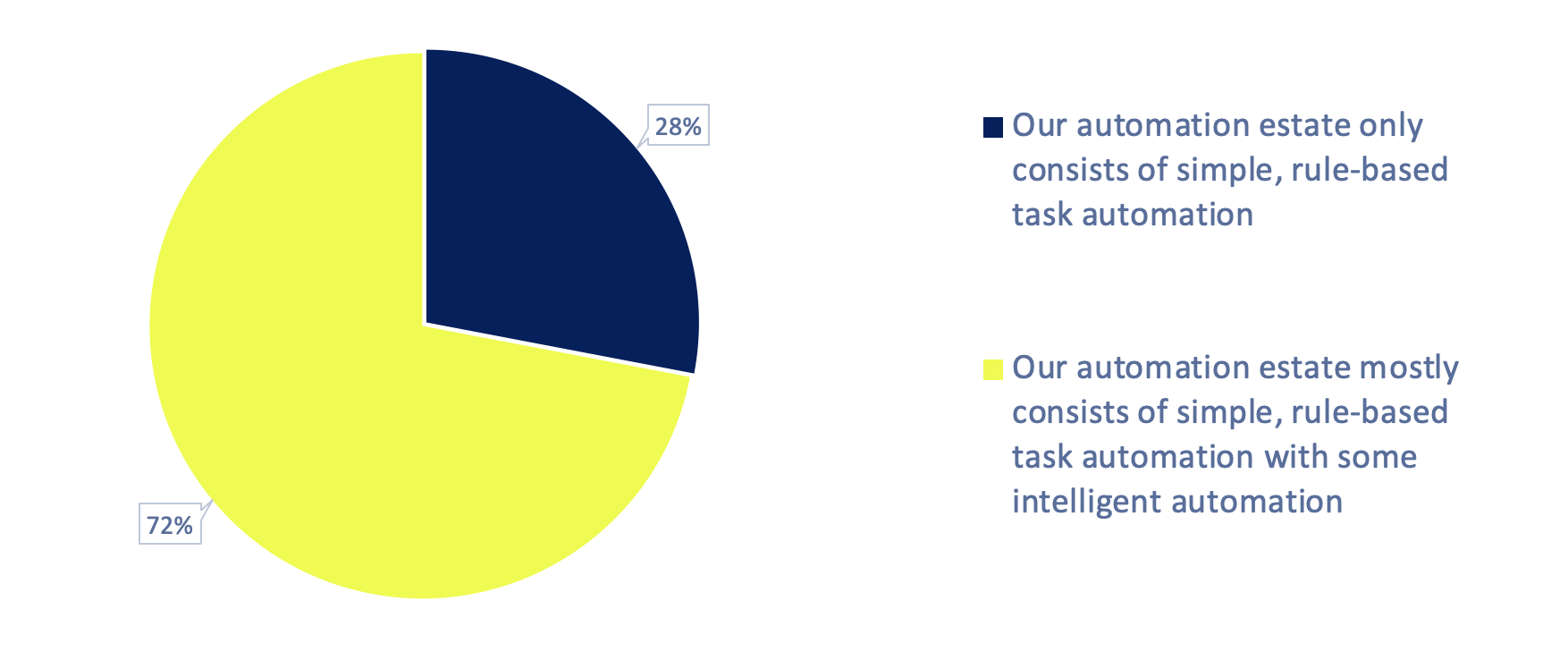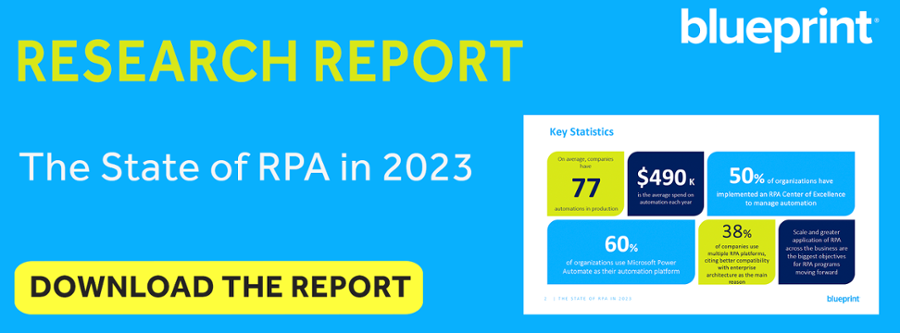7 RPA Objectives for 2024
Part of the research Blueprint performs every year on the State of RPA is identifying the objectives of RPA and goals automation practices are tackling next.
Organizations are in various points in their RPA journeys, however that doesn’t mean that they don’t face similar challenges and have the same aims. According to Blueprint’s 2023 edition of the State of RPA, these are the seven RPA objectives that automation practices are looking to achieve in 2024.
Objective #1 - Apply RPA to More Areas of the Business
The most prioritized objective for the future that Blueprint’s research respondents reported is applying automation to more areas of their organization.
It goes without saying that RPA practices have seen significant returns from automation in terms of efficiency, quality, and speed. The ROI has been so fruitful that organizations are now eager to increase application to more areas of the business in order to maximize those returns.
This objective could also be why RPA practices are eagerly establishing centralized, federated, or de-centralized RPA Centers of Excellence. A central team to manage, govern, and standardize automation also helps to accelerate universal application in a responsible, secure, and effective manner.
Objective #2 – Achieve Scale and Automate More Processes
You can make the argument that both objectives #1 and #2 are similar, however they are nuanced. Objective #1 addresses the application of RPA across all departments and areas of the business. To date, automation has been predominantly localized to Finance, IT, and HR departments.
Objective #2 refers to accelerating and increasing automation design and delivery regardless of department, albeit, for the same benefits that organizations want to implement RPA to all business units.
Achieving scale by automating more business processes and tasks is simply another way to maximize the results and returns organizations have realized with RPA.
Objective #3 – Standardize RPA Practices
RPA was adopted and implemented in companies in different ways. According to Blueprint research, only 25% of respondents reported that they implemented automation with internal resources. The other 75% employed external parties to kick-start their RPA journey.

To further complicate matters, in some cases RPA was implemented at different times by different departments in the same organization. For example, IT adopted it first, and then Finance implemented RPA two years later with a different platform. Acquisitions and mergers have also served to increase disparate automation practices, technologies, and standards as well.
The result is a lack of standards that can sometimes resemble the wild west of technology. For that reason, organizations are eager to standardize their automation practices to increase delivery speed, quality, and resilience. That could also indicate why establishing RPA Centers of Excellence are so top of mind right now.
Objective #4 – Reduce RPA’s Total Cost of Ownership (TCO) and Operational Expense (OPEX)
Cost reduction is a perennial objective for all organizations. In the case of RPA, it’s more important now than ever because legacy providers have significantly increased their licensing fees and costs.
One way companies are looking to reduce their RPA total cost of ownership is by migrating to much more cost-effective automation platforms like Microsoft Power Automate.
Power Automate doesn’t just deliver incredibly competitive pricing—particularly through their updated Power Automate Premium Licenses; they also offer dramatic cost savings through reduced infrastructure costs and leveraging existing investments made with Microsoft’s suite of products.
Objectives #5 and #6 – Increase the Use of Intelligent Automation
Coincidentally, the fifth and sixth most important automation objectives organizations are focusing on for 2024 both have to do with increasing the application of intelligent automation.
The fifth most prioritized objective for RPA practices is implementing more artificial intelligence in their automation practice to move beyond task- and rule-based automation to automating decision-based business processes.
The sixth highest objective is automating more complex, end-to-end business processes instead of just swivel-chair business tasks.
Both RPA objectives are achieved through the implementation of intelligent automation which combines RPA with AI technologies like machine learning and natural language processing to automate complex, decision-based business processes.
According to recent Blueprint research, organizations have already started experimenting with intelligent automation, however they are incredibly keen to increase its application and realize the exponential returns and benefits it offers.

Objective #7 – Improve RPA Governance
Improving RPA governance has been a priority for automation practices for quite some time. Considering that many RPA programs are still not very mature and in the early days of their automation journeys, companies are still gathering lessons that they’re learning.
One of those lessons is that a sophisticated and robust governance model to standardize and manage RPA design, delivery, maintenance, and optimization is needed.
Our research indicated that only 50% of organizations had established RPA Centers of Excellence to govern their automation program. That says there’s work to be done. Coincidentally, 41% of those that had yet to set up and RPA CoE, have concrete plans to do so in the near future to improve and reinforce their automation governance.
Conclusion
Like any other enterprise initiative, there is always room for improvement to cut costs and increase returns. RPA is no different. To that end, the following are the priorities and objectives automation practices will focus on in 2024 according to Blueprint’s research:
#1 - Applying RPA to more areas of the business
#2 - Achieving scale and automating more processes
#3 - Standardizing RPA practices
#4 - Reducing RPA’s total cost of ownership and operational expense
#5 and #6 – Increasing the use of intelligent automation
#7 – Improving RPA governance.
For all the insight on the State of RPA in 2023 like how much organizations are spending on automation annually, the size of RPA toolchains, and the most used RPA platforms, download your free copy of Blueprint’s research report while it’s still available.
Share this
Recent Stories

7 Automation Predictions for 2024

5 RPA Resolutions to Keep for 2024




